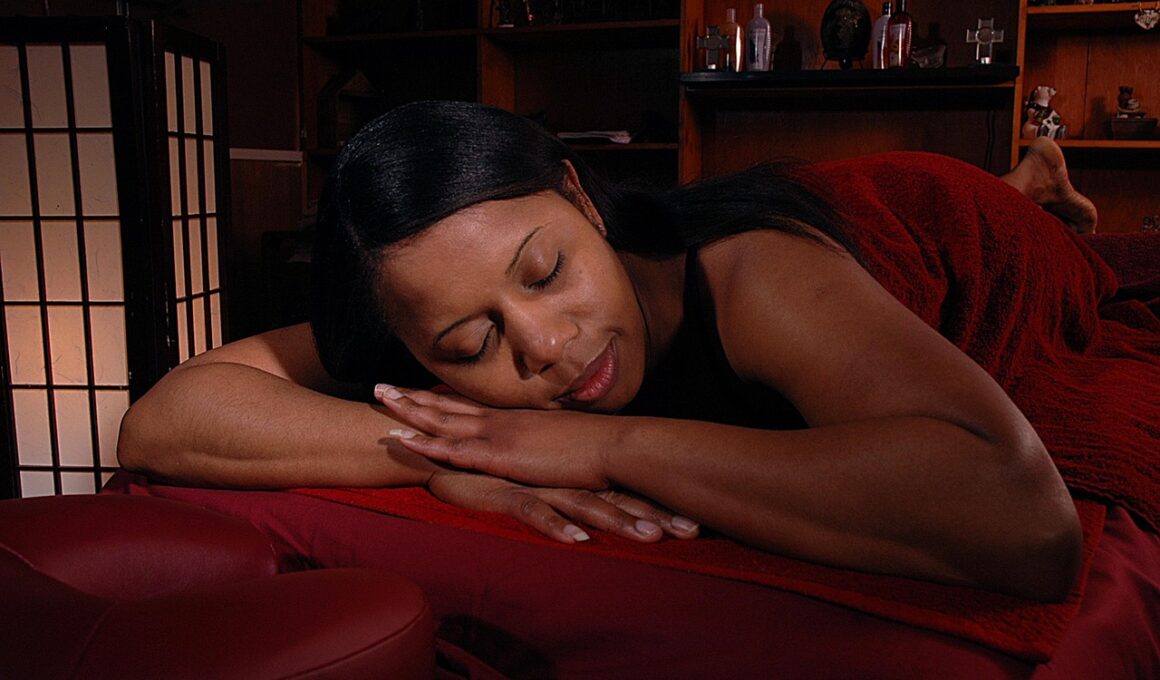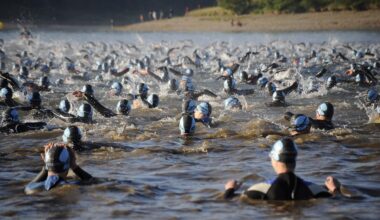Cold Therapy Benefits for Post-Marathon Healing
After completing a marathon, athletes often seek effective strategies to expedite recovery. One promising method is cold therapy, which involves applying cold to the body to alleviate soreness and reduce inflammation. Specifically, this technique can significantly enhance recovery post-race. Cold therapy improves blood circulation, lessening swelling and soreness. Additionally, it stimulates the body’s natural healing process. Many athletes utilize ice packs, ice baths, or specialized cryotherapy treatments. Consistent application can yield beneficial results when adopted as part of a post-marathon routine. By lowering tissue temperature, cold therapy can also ease muscle tightness, leading to improved flexibility. Athletes often report feeling refreshed and rejuvenated after implementing these recovery methods. Furthermore, incorporating cold therapy into your regimen can potentially minimize the risk of injury and enhance readiness for future exertion. Following strenuous physical activity, your body endures micro-tears in muscle fibers. Cold packs can directly counteract this damage. Thus, prioritizing these therapies during recovery can be advantageous for athletes determined to return to optimal performance levels. Persistently utilizing ice or cold applications should help runners recover effectively after grueling races like marathons.
Cold therapy not only brings immediate post-race benefits but supports long-term recovery strategies. To maximize its effectiveness, consider incorporating additional recovery methods alongside cold therapy. Methods such as foam rolling and stretching complement cold exposure, improving overall flexibility and preventing stiffness. Nutrition and hydration also play vital roles in your recovery. Consuming adequate post-race nutrients, including proteins and electrolytes, supports muscle repair and replenishes energy stores. Proper hydration is equally crucial, as it aids in eliminating toxins from the body. If you want optimal results, develop a balanced recovery triangle that includes cold therapy, nutrition, and hydration. Moreover, every athlete reacts differently to cold exposure, so listening to your body is imperative. Keeping a recovery journal may help you understand the best practices that yield results. As you experiment with various post-marathon recovery strategies, monitor which combinations work best for you. On a psychological level, knowing you are taking care of your body can boost morale and encourage continued training efforts. Remember, a comprehensive approach to recovery will promote long-term success and ensure your body stays competitive and healthy throughout your athletic career.
Understanding the Science Behind Cold Therapy
Cold therapy works primarily by constricting blood vessels and numbing the affected area, which can alleviate pain effectively. When you apply cold, the initial shock induces vasoconstriction, reducing blood flow to the area. This decrease in blood flow curtails inflammation and reduces metabolic activity. Following this phase, rewarming occurs, leading to vasodilation, which enhances blood flow, bringing essential nutrients and oxygen for tissue repair. Therefore, utilizing a combination of cold followed by heat can create an ideal environment for recovery. The science is clear: wrapping cold around sore muscles decreases secondary tissue damage significantly. Furthermore, cold therapy can also stimulate the production of anti-inflammatory substances within the body. It essentially signals your hormonal and immune systems to focus on recovery instead of inflammation. Research has demonstrated the efficacy of cold therapy in reducing delayed onset muscle soreness, a common consequence of intense physical activity, such as marathon running. By utilizing this method strategically, you can boost your recovery regimen. Cold exposure’s influence on muscle repair and growth signals is essential for any athlete looking to enhance performance while minimizing downtime.
Combining cold therapy with other recovery methods can create a powerful multi-faceted recovery plan. One of the most effective combinations involves alternating between cold therapy and active recovery techniques. Gentle stretching or light jogging after cold application promotes blood circulation while preventing stiffness. This combination leverages the benefits of both methods more effectively. Additionally, consider integrating other recovery modalities like compression therapy, which works simultaneously by improving blood flow and reducing swelling. Massage, whether self-administered or professional, can also help reduce tension in your body. Each of these strategies, when used in tandem with cold therapy, promotes quicker recovery times. Organizationally, direction in your recovery schedule can aid your performance. Allocate specific times for cold therapy, along with other techniques, ensuring you don’t overdo it and embolden your recovery process. Also, during recovery, stay mindful of the signs your body sends you. Fatigue or persistent soreness indicates a need for extended rest or alternative recovery strategies. Make adjustments to your methods based on experience and body feedback. By personalizing your post-marathon recovery plan, you can maximize the benefits offered by cold therapy and associated techniques.
Implementing Cold Therapy in Your Recovery Routine
To integrate cold therapy into your recovery routine, start by determining how often you will apply the treatment. Many experienced athletes suggest utilizing cold therapy within the first 24 to 48 hours after completing a marathon. Ideally, ice packs or baths should be used at intervals of 15 to 20 minutes, allowing for breaks in between sessions. Consistency is vital; therefore, set reminders to ensure you stay on track with your recovery schedule. Additionally, be conscious of your environment to maximize the effectiveness of your cold application. For those in colder climates, exposing your muscles to outside temperatures may suffice, while others may prefer more controlled environments using ice packs or globes. If you opt for ice baths, start with shorter exposure times and gradually increase the duration as you adapt. Adjust the temperature according to your comfort level while still attaining the desired effects. Consider exploring various methods, such as gel packs or cold tubs, to find what works best. Personal comfort can lead to consistent cold therapy use, thus aiding your healing post-marathon.
Beyond physical benefits, cold therapy can offer psychological advantages to post-marathon recovery. Athletes often encounter not only physical fatigue but mental exhaustion following an intense event. Techniques such as cold exposure can induce a calming effect, improving overall mental well-being. Many runners report feeling invigorated after cold application, lending an overall sense of freshness. This emotional boost can be crucial in maintaining motivation levels and setting future training goals. For those experiencing post-race blues, cold therapy might offer not just physical recovery but enhanced emotional resilience. Consider incorporating mindfulness practices during cold treatments, such as focused breathing or visualization techniques, to deepen the experience. By coupling relaxation with therapy, you can establish a more holistic approach to recovery. Motivation and mental clarity are essential components of any training regimen; thus, make time to nurture your mental health in tandem with physical recovery efforts. Therefore, recognizing both the mental and physical aspects yielding positive effects strengthens your holistic approach to recovery post-marathon. Ultimately, ensuring a balanced focus will promote improved performance levels in future marathons and races.
Conclusion and Future Considerations
In summary, cold therapy offers substantial benefits for post-marathon recovery. Implementing this method alongside outros recovery strategies provides athletes with a well-rounded approach crucial for optimal healing. Cold therapy recoups muscle damage while simultaneously refreshing mental acuity, both fundamental for performance enhancement. As you experiment with these techniques, record your findings and adapt your routine accordingly. Focus on personal responses to varying methods to maximize recovery times. Resistance to entering cold treatments may occur; however, embracing the initial discomfort will allow for positive results overall. Furthermore, recent advancements in cryotherapy technology present fresh opportunities for athletes seeking cutting-edge recovery techniques. New forms of cold therapy, such as localized cryofacials or compression cooling systems, can diversify your arsenal as an athlete. Always prioritize safety when experimenting with alternative therapies and remain in tune with your body’s needs. Consider consulting with a medical professional, particularly if you have existing health concerns. As you move forward, maintain a focus on recovery, personalized strategies, and continuous improvement. With commitment, you’ll unlock your potential and achieve greater milestones in your athletic journey.
Ultimately, the journey through marathon training and recovery is interconnected, and what you learn during recovery will inform your future training cycles. Pay attention to how your body responds to various recovery techniques, such as cold therapy. Monitor your energy levels and overall well-being as your training intensifies. Taking each race as a learning experience can help refine your approach to cold therapy and its incorporation into post-race routines. By being adaptable, you can create a structured yet flexible recovery process that suits your individual needs. Embrace the challenges and triumphs along the way, making adaptations as necessary to continue improving. Infusing your training with insights gained post-marathon will only bolster future performances. Teasing apart what methods are most effective for your body can also help develop a personalized recovery blueprint. If you enjoy the outcomes of cold therapy, explore additional modalities such as heat or contrast therapies. A comprehensive approach to recovery that includes understanding your individual preferences and responses will promote sustainability in your training and recovery. Your adventure in marathon training doesn’t end with completing a race; rather, it continually evolves as you embrace both the trials and triumphs of being an athlete.


